2025秋高考英语复习专题二阅读理解课件
图片预览

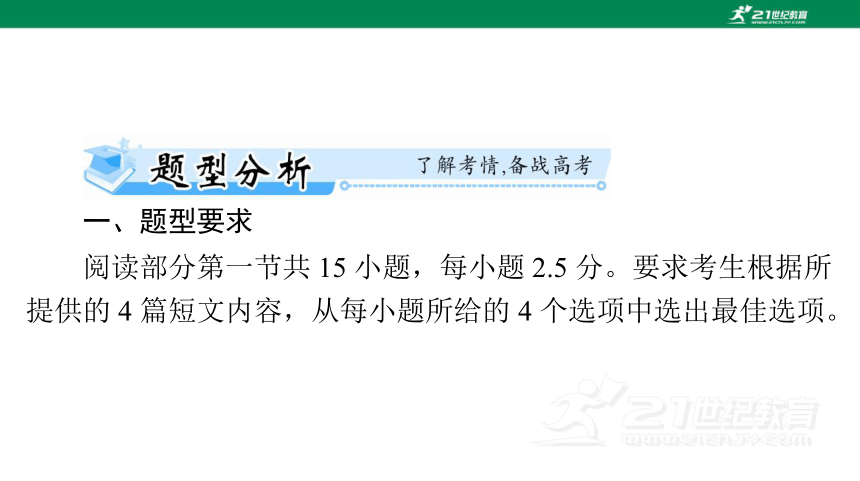
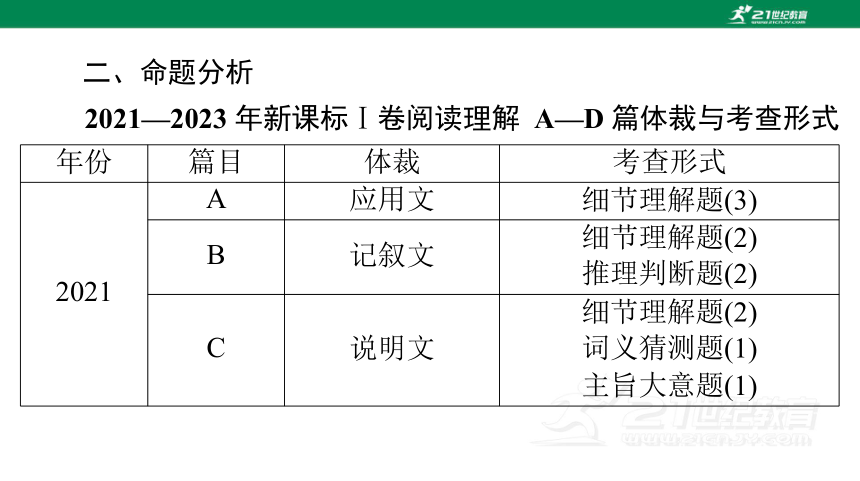
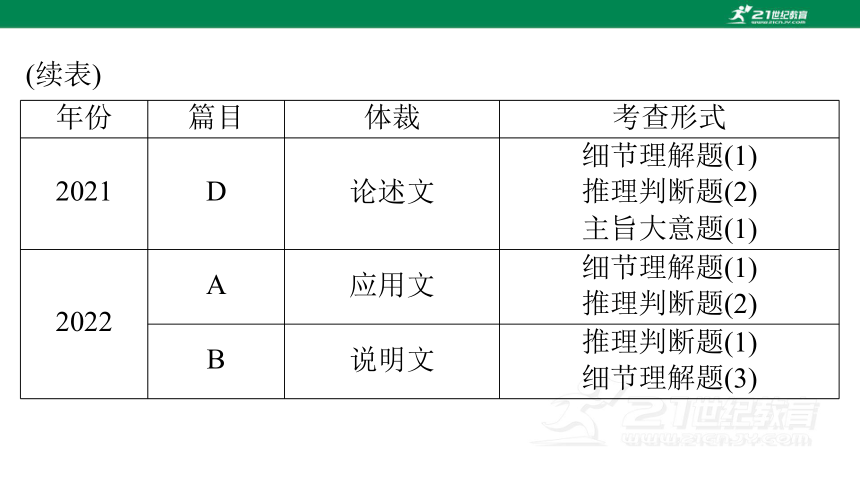
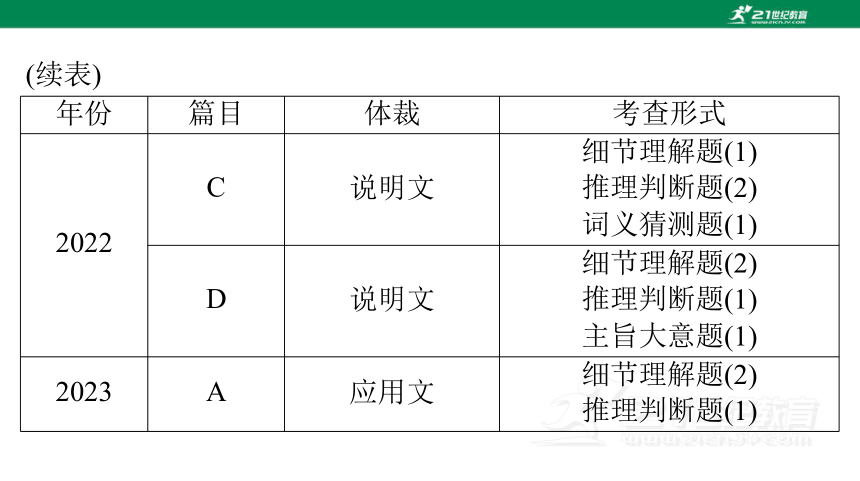
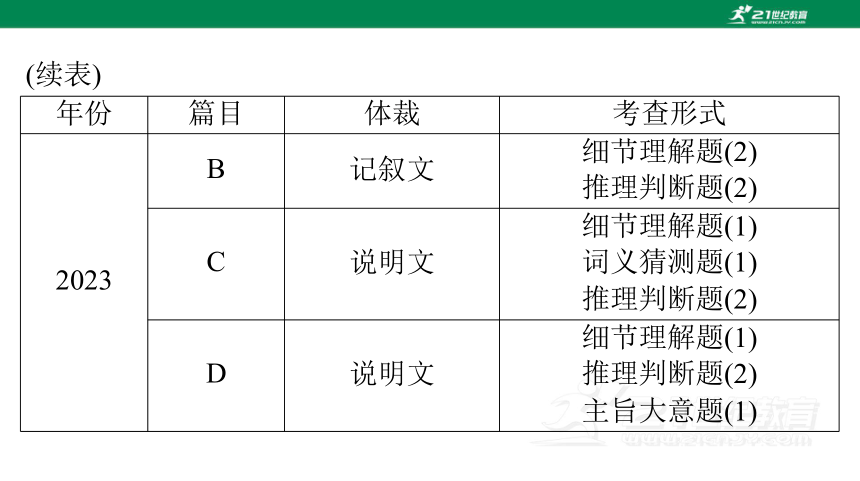
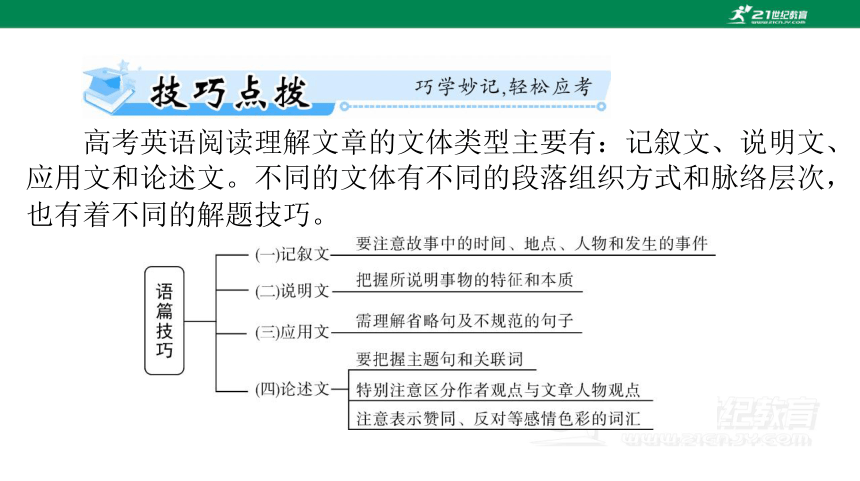

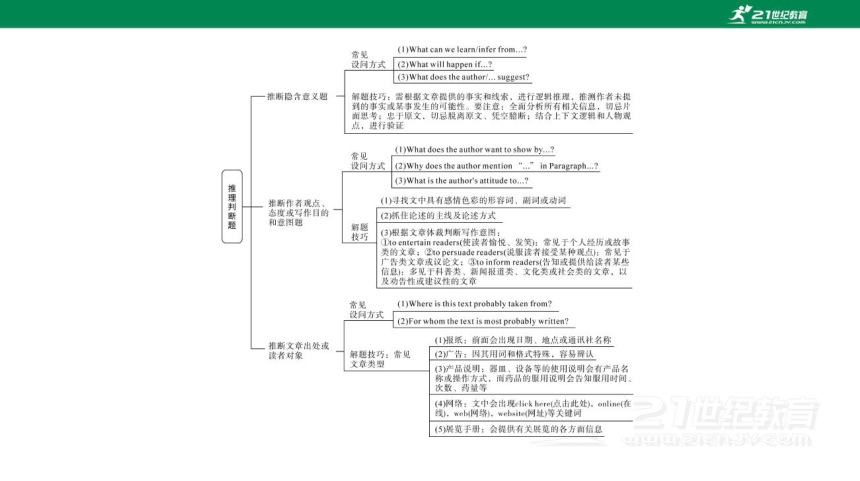
文档简介
(共26张PPT)
专题二
阅读理解
一、题型要求
阅读部分第一节共 15 小题,每小题 2.5 分。要求考生根据所
提供的 4 篇短文内容,从每小题所给的 4 个选项中选出最佳选项。
年份 篇目 体裁 考查形式
2021 A 应用文 细节理解题(3)
B 记叙文 细节理解题(2)
推理判断题(2)
C 说明文 细节理解题(2)
词义猜测题(1)
主旨大意题(1)
二、命题分析
2021—2023 年新课标Ⅰ卷阅读理解 A—D 篇体裁与考查形式
年份 篇目 体裁 考查形式
2021 D 论述文 细节理解题(1)
推理判断题(2)
主旨大意题(1)
2022 A 应用文 细节理解题(1)
推理判断题(2)
B 说明文 推理判断题(1)
细节理解题(3)
(续表)
年份 篇目 体裁 考查形式
2022 C 说明文 细节理解题(1)
推理判断题(2)
词义猜测题(1)
D 说明文 细节理解题(2)
推理判断题(1)
主旨大意题(1)
2023 A 应用文 细节理解题(2)
推理判断题(1)
(续表)
年份 篇目 体裁 考查形式
2023 B 记叙文 细节理解题(2)
推理判断题(2)
C 说明文 细节理解题(1)
词义猜测题(1)
推理判断题(2)
D 说明文 细节理解题(1)
推理判断题(2)
主旨大意题(1)
(续表)
高考英语阅读理解文章的文体类型主要有:记叙文、说明文、
应用文和论述文。不同的文体有不同的段落组织方式和脉络层次,
也有着不同的解题技巧。
高考阅读理解的考查形式主要有四大类:细节理解题、推理
判断题、主旨大意题、词义/句意猜测题。
词类 例词
褒义词 support(支持),supportive(支持的),approve(赞成),approving(赞同的),for(支持),in favour of(支持),optimistic(乐观的),positive(积极的),helpful(有帮助的),admiring(赞赏的),interested(感兴趣的),praise(赞扬)
常见的表示态度的词
词类 例词
贬义词 critical(批评的),negative(否定的),suspicious(怀疑的),disappointed(失望的),biased(有偏见的),doubtful(怀疑的),pessimistic(悲观的),depressed(沮丧的),uninterested(冷漠的),skeptical(怀疑的),opposed(反对的),doubt(怀疑)
中性词 factual(事实的),objective(客观的),neutral(中立的)
(续表)
(2024·新课标Ⅰ卷)
阅读下列短文,从每题所给的 A、B、C、D 四个选项中选出
最佳选项。
In the race to document the species on Earth before they go
extinct, researchers and citizen scientists have collected billions of
records.Today, most records of biodiversity are often in the form of
photos, videos, and other digital records.Though they are useful for
detecting shifts in the number and variety of species in an area, a new
Stanford study has found that this type of record is not perfect.
“With the rise of technology it is easy for people to make
observations of different species with the aid of a mobile
application ,” said Barnabas Daru, who is lead author of the study
and assistant professor of biology in the Stanford School of
Humanities and Sciences.“These observations now outnumber the
primary data that comes from physical specimens(标本), and since we
are increasingly using observational data to investigate how species
are responding to global change, I wanted to know: Are they
usable?”
Using a global dataset of 1.9 billion records of plants, insects,
birds, and animals, Daru and his team tested how well these data
represent actual global biodiversity patterns.
“We were particularly interested in exploring the aspects of
sampling that tend to bias(使有偏差) data, like the greater likelihood
of a citizen scientist to take a picture of a flowering plant instead of
the grass right next to it,” said Daru.
Their study revealed that the large number of observation-only
records did not lead to better global coverage.Moreover, these data are
biased and favor certain regions, time periods, and species.This makes
sense because the people who get observational biodiversity data on
mobile devices are often citizen scientists recording their encounters
with species in areas nearby.These data are also biased toward certain
species with attractive or eye-catching features.
What can we do with the imperfect datasets of biodiversity
“Quite a lot,” Daru explained.“Biodiversity apps can use our
study results to inform users of oversampled areas and lead them to
places—and even species—that are not well-sampled.To improve the
quality of observational data, biodiversity apps can also encourage
users to have an expert confirm the identification of their uploaded
image.”
本文是一篇说明文。文章主要介绍了斯坦福大学的一项研究
发现,数字生物多样性记录存在偏差,建议应用程序引导公民科
学家获取更好的数据。
1.What do we know about the records of species collected now
A.They are becoming outdated.
B.They are mostly in electronic form.
C.They are limited in number.
D.They are used for public exhibition.
B
细 节 理 解 题 。 根 据 第 一 段 “Today, most records of
biodiversity are often in the form of photos, videos, and other digital
records.(今天,大多数生物多样性记录通常以照片、视频和其他数
字记录的形式出现。)”可知,现在收集的物种记录大多是以电子
形式存在的。故选 B。
2.What does Daru's study focus on
A.Threatened species.
C.Observational data.
B.Physical specimens.
D.Mobile applications.
C
细 节 理 解 题 。 根 据 第 二 段 “These observations now
outnumber the primary data that comes from physical specimens( 标
本 ), and since we are increasingly using observational data to
investigate how species are responding to global change, I wanted to
know: Are they usable (这些观察结果现在超过了来自物理标本的
原始数据,而且由于我们越来越多地使用观察数据来研究物种如
何应对全球变化,我想知道:它们有用吗?)”和第四段“We were
particularly interested in exploring the aspects of sampling that tend to
bias(使有偏差) data, like the greater likelihood of a citizen scientist to
take a picture of a flowering plant instead of the grass right next to
it,” said Daru.(Daru 说“我们特别感兴趣的是探索取样容易产生
数据偏差的方面,比如公民科学家更有可能拍摄开花植物的照片,
而不是它旁边的草。”)”可知,Daru 的研究聚焦于观察数据,即
人们通过移动应用记录的物种观察数据。故选 C。
3.What has led to the biases according to the study
A.Mistakes in data analysis.
B.Poor quality of uploaded pictures.
C.Improper way of sampling.
D.Unreliable data collection devices.
C 细节理解题。根据第四段“We were particularly interested in
exploring the aspects of sampling that tend to bias( 使 有 偏 差 ) data,
like the greater likelihood of a citizen scientist to take a picture of a
flowering plant instead of the grass right next to it,” said Daru.(Daru
说“我们特别感兴趣的是探索取样容易产生数据偏差的方面,比
如公民科学家更有可能拍摄开花植物的照片,而不是它旁边的
草。”)”以及第五段“This makes sense because the people who get
observational biodiversity data on mobile devices are often citizen
scientists recording their encounters with species in areas nearby.( 这
是有道理的,因为在移动设备上获得观察生物多样性数据的人通
常是公民科学家,他们记录了他们在附近地区接触的物种。)”可
知,导致数据偏差的原因是采样方式的不当。故选 C。
4.What is Daru's suggestion for biodiversity apps
A.Review data from certain areas.
B.Hire experts to check the records.
C.Confirm the identity of the users.
D.Give guidance to citizen scientists.
D 推理判断题。根据最后一段“Biodiversity apps can use our
study results to inform users of oversampled areas and lead them to
places—and even species—that are not well-sampled.To improve the
quality of observational data, biodiversity apps can also encourage
users to have an expert confirm the identification of their uploaded
image.(生物多样性应用程序可以使用我们的研究结果来告知用户
样本过多的地区,并将他们引导到样本不足的地方,甚至是物种。
为了提高观测数据的质量,生物多样性应用程序还可以鼓励用户
让专家确认他们上传图像的身份。)”可知,Daru 建议生物多样性
应用应该给公民科学家提供指导。故选 D。
专题二
阅读理解
一、题型要求
阅读部分第一节共 15 小题,每小题 2.5 分。要求考生根据所
提供的 4 篇短文内容,从每小题所给的 4 个选项中选出最佳选项。
年份 篇目 体裁 考查形式
2021 A 应用文 细节理解题(3)
B 记叙文 细节理解题(2)
推理判断题(2)
C 说明文 细节理解题(2)
词义猜测题(1)
主旨大意题(1)
二、命题分析
2021—2023 年新课标Ⅰ卷阅读理解 A—D 篇体裁与考查形式
年份 篇目 体裁 考查形式
2021 D 论述文 细节理解题(1)
推理判断题(2)
主旨大意题(1)
2022 A 应用文 细节理解题(1)
推理判断题(2)
B 说明文 推理判断题(1)
细节理解题(3)
(续表)
年份 篇目 体裁 考查形式
2022 C 说明文 细节理解题(1)
推理判断题(2)
词义猜测题(1)
D 说明文 细节理解题(2)
推理判断题(1)
主旨大意题(1)
2023 A 应用文 细节理解题(2)
推理判断题(1)
(续表)
年份 篇目 体裁 考查形式
2023 B 记叙文 细节理解题(2)
推理判断题(2)
C 说明文 细节理解题(1)
词义猜测题(1)
推理判断题(2)
D 说明文 细节理解题(1)
推理判断题(2)
主旨大意题(1)
(续表)
高考英语阅读理解文章的文体类型主要有:记叙文、说明文、
应用文和论述文。不同的文体有不同的段落组织方式和脉络层次,
也有着不同的解题技巧。
高考阅读理解的考查形式主要有四大类:细节理解题、推理
判断题、主旨大意题、词义/句意猜测题。
词类 例词
褒义词 support(支持),supportive(支持的),approve(赞成),approving(赞同的),for(支持),in favour of(支持),optimistic(乐观的),positive(积极的),helpful(有帮助的),admiring(赞赏的),interested(感兴趣的),praise(赞扬)
常见的表示态度的词
词类 例词
贬义词 critical(批评的),negative(否定的),suspicious(怀疑的),disappointed(失望的),biased(有偏见的),doubtful(怀疑的),pessimistic(悲观的),depressed(沮丧的),uninterested(冷漠的),skeptical(怀疑的),opposed(反对的),doubt(怀疑)
中性词 factual(事实的),objective(客观的),neutral(中立的)
(续表)
(2024·新课标Ⅰ卷)
阅读下列短文,从每题所给的 A、B、C、D 四个选项中选出
最佳选项。
In the race to document the species on Earth before they go
extinct, researchers and citizen scientists have collected billions of
records.Today, most records of biodiversity are often in the form of
photos, videos, and other digital records.Though they are useful for
detecting shifts in the number and variety of species in an area, a new
Stanford study has found that this type of record is not perfect.
“With the rise of technology it is easy for people to make
observations of different species with the aid of a mobile
application ,” said Barnabas Daru, who is lead author of the study
and assistant professor of biology in the Stanford School of
Humanities and Sciences.“These observations now outnumber the
primary data that comes from physical specimens(标本), and since we
are increasingly using observational data to investigate how species
are responding to global change, I wanted to know: Are they
usable?”
Using a global dataset of 1.9 billion records of plants, insects,
birds, and animals, Daru and his team tested how well these data
represent actual global biodiversity patterns.
“We were particularly interested in exploring the aspects of
sampling that tend to bias(使有偏差) data, like the greater likelihood
of a citizen scientist to take a picture of a flowering plant instead of
the grass right next to it,” said Daru.
Their study revealed that the large number of observation-only
records did not lead to better global coverage.Moreover, these data are
biased and favor certain regions, time periods, and species.This makes
sense because the people who get observational biodiversity data on
mobile devices are often citizen scientists recording their encounters
with species in areas nearby.These data are also biased toward certain
species with attractive or eye-catching features.
What can we do with the imperfect datasets of biodiversity
“Quite a lot,” Daru explained.“Biodiversity apps can use our
study results to inform users of oversampled areas and lead them to
places—and even species—that are not well-sampled.To improve the
quality of observational data, biodiversity apps can also encourage
users to have an expert confirm the identification of their uploaded
image.”
本文是一篇说明文。文章主要介绍了斯坦福大学的一项研究
发现,数字生物多样性记录存在偏差,建议应用程序引导公民科
学家获取更好的数据。
1.What do we know about the records of species collected now
A.They are becoming outdated.
B.They are mostly in electronic form.
C.They are limited in number.
D.They are used for public exhibition.
B
细 节 理 解 题 。 根 据 第 一 段 “Today, most records of
biodiversity are often in the form of photos, videos, and other digital
records.(今天,大多数生物多样性记录通常以照片、视频和其他数
字记录的形式出现。)”可知,现在收集的物种记录大多是以电子
形式存在的。故选 B。
2.What does Daru's study focus on
A.Threatened species.
C.Observational data.
B.Physical specimens.
D.Mobile applications.
C
细 节 理 解 题 。 根 据 第 二 段 “These observations now
outnumber the primary data that comes from physical specimens( 标
本 ), and since we are increasingly using observational data to
investigate how species are responding to global change, I wanted to
know: Are they usable (这些观察结果现在超过了来自物理标本的
原始数据,而且由于我们越来越多地使用观察数据来研究物种如
何应对全球变化,我想知道:它们有用吗?)”和第四段“We were
particularly interested in exploring the aspects of sampling that tend to
bias(使有偏差) data, like the greater likelihood of a citizen scientist to
take a picture of a flowering plant instead of the grass right next to
it,” said Daru.(Daru 说“我们特别感兴趣的是探索取样容易产生
数据偏差的方面,比如公民科学家更有可能拍摄开花植物的照片,
而不是它旁边的草。”)”可知,Daru 的研究聚焦于观察数据,即
人们通过移动应用记录的物种观察数据。故选 C。
3.What has led to the biases according to the study
A.Mistakes in data analysis.
B.Poor quality of uploaded pictures.
C.Improper way of sampling.
D.Unreliable data collection devices.
C 细节理解题。根据第四段“We were particularly interested in
exploring the aspects of sampling that tend to bias( 使 有 偏 差 ) data,
like the greater likelihood of a citizen scientist to take a picture of a
flowering plant instead of the grass right next to it,” said Daru.(Daru
说“我们特别感兴趣的是探索取样容易产生数据偏差的方面,比
如公民科学家更有可能拍摄开花植物的照片,而不是它旁边的
草。”)”以及第五段“This makes sense because the people who get
observational biodiversity data on mobile devices are often citizen
scientists recording their encounters with species in areas nearby.( 这
是有道理的,因为在移动设备上获得观察生物多样性数据的人通
常是公民科学家,他们记录了他们在附近地区接触的物种。)”可
知,导致数据偏差的原因是采样方式的不当。故选 C。
4.What is Daru's suggestion for biodiversity apps
A.Review data from certain areas.
B.Hire experts to check the records.
C.Confirm the identity of the users.
D.Give guidance to citizen scientists.
D 推理判断题。根据最后一段“Biodiversity apps can use our
study results to inform users of oversampled areas and lead them to
places—and even species—that are not well-sampled.To improve the
quality of observational data, biodiversity apps can also encourage
users to have an expert confirm the identification of their uploaded
image.(生物多样性应用程序可以使用我们的研究结果来告知用户
样本过多的地区,并将他们引导到样本不足的地方,甚至是物种。
为了提高观测数据的质量,生物多样性应用程序还可以鼓励用户
让专家确认他们上传图像的身份。)”可知,Daru 建议生物多样性
应用应该给公民科学家提供指导。故选 D。
